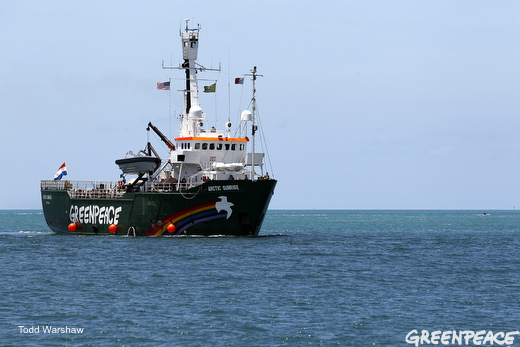
There seem to be two rules to being a passenger on a Greenpeace ship. One: if you take a beer from the refrigerator, always remember to log it on the drinks sheet. (And pay your bar bill before you leave the boat—otherwise, I believe they make you walk the plank.) Two: there is no such thing as a passenger on a Greenpeace ship. Everyone works onboard, with chores starting at 8 AM—which is how I came to find myself recently on the Arctic Sunrise’s poop deck (yes, that’s the name), sorting the glass recyclables from the organic trash. At first, I have to say, I was a bit annoyed—I’m a journalist, not an assistant galley slave. But over the few days I spent onboard Greenpeace’s Arctic Sunrise as it sailed through the Dry Tortugas, I learned why the vessel’s spirit of cooperation and conservation represents what it means to be truly green.
Greenpeace’s navy is best known for its headline-generating protests—think of the Rainbow Warrior iconic clashes with whaling vessels in the 1980s. But I joined the Arctic Sunrise—a former Norwegian icebreaker that is one of three Greenpeace ships scattered around the world—in mid-August for the first phase of a two-month long scientific mission to the Gulf of Mexico. Greenpeace provides rides and support to rotating teams of scientists carrying out oil-spill related studies, from plankton health near the spill site to surveys of marine mammals who might have been impacted by the crude. Given the controversy unfolding over the true extent of the spill underwater—the government says much of the oil has disappeared; independent scientists are skeptical—the voyage couldn’t have been better timed. “This is about bearing witness to what’s going on,” says Paul Horsman, a former Greenpeace activist and the director for the TckTckTck campaign on climate change.
First up were the Dry Tortugas, a series of uninhabited islands west of the Florida Keys and named by Ponce de Leon in 1513 for their turtles (there were lots of them back then) and fresh water supplies (there wasn’t any). Marine scientists Chuck Messing and Joe Lopez of Florida’s Nova Southeastern University were onboard to survey populations of sea sponges, ancient underwater animals that are plentiful in the relatively pristine coral reefs of the Tortugas. Because sponges filter huge amounts of water as they search for tasty plankton, they can be a bellwether species for marine health. “It’s great to actually be able to see the habitat you’re trying to protect,” says Lopez.
The sponges were OK—the Tortugas, a protected marine area, were spared any oil from the spill thanks to fortunate ocean currents. As the Arctic Sunrise sails closer to the spill site, that’s not likely to be true, and in the Tortugas there were the earnest discussions you’d expect onboard a Greenpeace ship about the need to get America off oil, to create a truly sustainable way of life. “This spill is a wakeup call,” says Dan Howells, Greenpeace USA’s deputy campaign director.
True words—words I’ve heard many times before as TIME’s environment writer. But it was the Arctic Sunrise itself that made those words mean something in a way I’d never experienced before. Here’s how I can explain it best: in British writer Ian McEwan’s recent novel Solar (don’t worry, it was about climate change, so you probably didn’t read it), there’s a scene where his main character Michael Beard takes a trip to the Arctic Circle, with others intellectuals and artists, to see climate change in action. Here’s how I described it in my review:
The journey is hilarious: Beard suffers frostbite in a rather uncomfortable place and is very nearly eaten by a polar bear. But even better is the way McEwan deftly contrasts the high ideals of the travelers — who call for a new, greener way of life — with their unacknowledged selfishness. The ship’s boot room, where people load and unload their polar gear, and which steadily descends into chaos, becomes a symbol of humanity’s problems with planetary management. “How were they to save the earth,” Beard wonders, “when it was so much larger than the boot room?”
Well, on the Arctic Sunrise the boot room—or its naval equivalent—is in fine, ordered shape. All waste onboard the ship that can be recycled is—not just because this is Greenpeace, but because when you’re at sea, there’s nowhere for waste to go. Everyone has a job and everyone has a role—and you’re expected to play your part. You can’t hire someone else to do your work—indeed, many of the crew man Greenpeace ships even though they could make more on a commercial vessel. You can’t take more than what you need—and why would you? So a voyage that could have easily been chaotic works because the boho, international crew—including the occasional journalist—comes togetherfor a common purpose. “The spirit of Greenpeace is found on these ships,” says Horsman, who should know—he met the mother of his son on a Greenpeace ship.
If the world is ever to properly manage the multitude of crises it faces—population growth, resource depletion, global warming—we’ll need to take a bit of that spirit onshore. It’s easy to remember how vulnerable you are encased in a cramped ship, knowing you that you have only what you’ve carried with you. But things aren’t so different on spaceship Earth, sailing through a sea of stars. We work together to take care of our home—or we perish.


